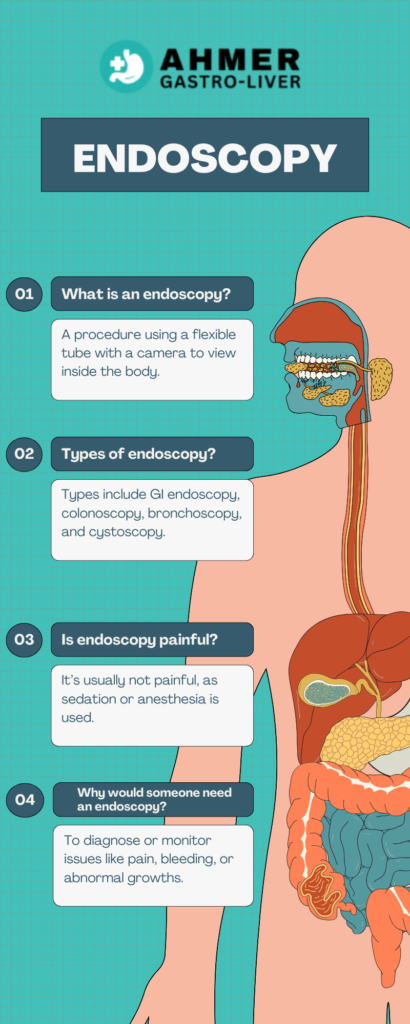Endoscopy is a medical procedure that allows doctors to examine the inside of the body using a specialized instrument called an endoscope. This minimally invasive technique is pivotal in diagnosing, monitoring, and sometimes even treating various medical conditions. Over the years, endoscopy has revolutionized healthcare, offering patients faster recovery times and more accurate diagnoses compared to traditional surgical methods.

What is Endoscopy?
An endoscope is a flexible tube equipped with a light and a camera, allowing doctors to visualize the inner structures of the body. The procedure can be performed through natural openings, such as the mouth, nose, or anus, or through small incisions made in the skin. Endoscopy provides high-definition images of organs and tissues, enabling healthcare professionals to detect abnormalities, take biopsies, or perform minor surgeries.
Types of Endoscopy
There are various types of endoscopic procedures, each designed to examine specific parts of the body. Some of the most common types include:
- Gastroscopy (Upper Endoscopy): This procedure examines the esophagus, stomach, and the upper part of the small intestine. It is commonly used to diagnose conditions like acid reflux, ulcers, and tumors.
- Colonoscopy: A colonoscopy is used to inspect the large intestine (colon) and rectum. It is a crucial tool in detecting colorectal cancer, polyps, and inflammatory bowel diseases such as Crohn’s disease.
- Bronchoscopy: This type of endoscopy examines the lungs and airways. It is commonly used to investigate persistent coughs, lung infections, or unusual chest X-ray results.
- Cystoscopy: This procedure examines the bladder and urethra. It is often used to diagnose urinary tract infections, bladder cancer, or other urinary issues.
- Laparoscopy (Minimally Invasive Surgery): Used in abdominal and pelvic areas, laparoscopy is often employed for surgical procedures, such as gallbladder removal or exploring conditions like endometriosis.
- Arthroscopy: This endoscopic procedure is used to examine joints, most commonly the knee, shoulder, or hip. It can help diagnose injuries or conditions like arthritis.
The Endoscopy Procedure
Endoscopy procedures are generally quick and minimally uncomfortable. Depending on the type of endoscopy and the area being examined, patients may be given a local anesthetic, sedation, or even general anesthesia.
Here’s a general overview of what to expect during an endoscopy:
- Preparation: Some endoscopic procedures require fasting or cleansing the digestive system beforehand. For example, a colonoscopy may require bowel prep to ensure the colon is clear.
- During the Procedure: The doctor will insert the endoscope into the appropriate opening or incision. The camera on the endoscope will transmit real-time images to a monitor, allowing the doctor to assess the area.
- After the Procedure: Most patients can go home the same day, though they may need someone to drive them if sedation was used. Mild discomfort, such as bloating or a sore throat, is common but usually resolves quickly.
Benefits of Endoscopy
- Minimally Invasive: Unlike traditional surgery, endoscopy requires only small incisions or natural body openings, reducing the risk of complications and minimizing recovery time.
- Quick Recovery: Because it is less invasive, recovery times are typically much faster. Most patients can resume their normal activities within a few days.
- Accurate Diagnosis: The ability to directly visualize internal organs allows doctors to diagnose conditions with a higher degree of accuracy, leading to better treatment outcomes.
- Therapeutic Applications: In addition to diagnosing conditions, endoscopy can also be used for treatment purposes, such as removing polyps, taking biopsies, or even repairing tears or holes in organs.
Risks and Considerations
Although endoscopy is generally safe, like any medical procedure, it carries some risks. These include:
- Infection: The insertion of any instrument into the body carries a small risk of infection.
- Bleeding: Especially if a biopsy or surgical procedure is performed during the endoscopy.
- Perforation: Rarely, the endoscope may cause a tear or hole in the organ being examined, though this is a rare complication.
- Reaction to Sedation: Some patients may experience side effects from the anesthesia or sedation used during the procedure.
However, the risk of these complications is low, and endoscopy is considered one of the safest and most effective diagnostic tools in modern medicine.
Endoscopy in the Future
As technology continues to evolve, so too does endoscopy. Advancements in imaging techniques, such as high-definition and 3D endoscopy, have enhanced the quality of visualizations, making it easier for doctors to spot even the smallest abnormalities. Additionally, robotic-assisted endoscopy may offer even greater precision in diagnosing and treating diseases.
With the growing importance of early detection in preventing and treating diseases like cancer, endoscopy plays a vital role in improving patient outcomes and quality of life.
Conclusion
Endoscopy has become an essential part of modern medicine, offering a minimally invasive way to diagnose, monitor, and treat a wide range of medical conditions. With its benefits of faster recovery, reduced complications, and improved diagnostic accuracy, endoscopy has revolutionized how doctors care for patients. As technology continues to advance, the potential for endoscopy to improve healthcare is limitless, making it an indispensable tool for both patients and healthcare providers.

My brother recommended I might like this web site. He was totally right. This post actually made my day. You cann’t imagine just how much time I had spent for this information! Thanks!